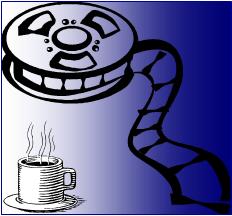

|
 |
Gilda (1946)
|
Please go to the new Coffee Coaster site implemented more gracefully in Wordpress. This page: http://brianrwright.com/CoffeeCoasterBlog/?p=3026 |
 Some time ago I saw the piano sheet music for the song, “Put the Blame on Mame,” with a picture of Rita Hayworth from the motion picture Gilda. The movie brings back strong memories, even though I had seen it more than fifty years ago as a young woman attending Western Michigan University. Why had it made such an impression on me? Through Barnes and Noble online I located a DVD of Gilda— which starred Glenn Ford and Rita Hayworth in black and white—and bought it. After viewing the film, I checked out the special features... which, among others, showed Rita dancing with Fred Astaire. How interesting and entertaining in its own right! I was reminded of her grace and expertise in the art of dance; in fact, Astaire once asserted that Rita was his favorite dance partner.
Some time ago I saw the piano sheet music for the song, “Put the Blame on Mame,” with a picture of Rita Hayworth from the motion picture Gilda. The movie brings back strong memories, even though I had seen it more than fifty years ago as a young woman attending Western Michigan University. Why had it made such an impression on me? Through Barnes and Noble online I located a DVD of Gilda— which starred Glenn Ford and Rita Hayworth in black and white—and bought it. After viewing the film, I checked out the special features... which, among others, showed Rita dancing with Fred Astaire. How interesting and entertaining in its own right! I was reminded of her grace and expertise in the art of dance; in fact, Astaire once asserted that Rita was his favorite dance partner.
Directed by Charles Vidor
Written by E.A. Ellington
Rita Hayworth... Gilda Mundson Farrell
Glenn Ford ... Johnny Farrell
George Macready ... Ballin Mundson
The movie Gilda was a big hit from Columbia in 1946. The time setting for the picture is post World War II. I remember that time personally; change was the name of the game. More than 12 million men had left their homes to enter this war, and it is reported that more than 15 million civilians during the war moved from place to place inside the country, often in search of jobs at defense plants. At war's end, millions of men came home; the jobs in the defense plants changed back to manufacturing peacetime goods. We saw the end of rationing, too. Women who had worked in these plants to support the war, while at the same time taking care of their families at home, were basically told to return to their homes fulltime and let the men have the jobs again.
Ref. the wonderful movie, Swing Shift, w/ Goldie Hawn and Kurt Russell.
However, these women were no longer the naďve, dependent homemakers they had been before the war. For four long years they had functioned as independent persons: earning a living, raising their children, and keeping house as well. Also, the men who returned had lost the innocence of youth, they grew up in the madness of war, learning to obey or to give orders in an authoritarian realm; they also suffered traumatic experiences and needed time to heal. The veterans came home to unemployment and a world far different from the one they had left. Many personal relationships were strained as the roles of men and women shifted and the economy was transformed to the needs of peace.
The Academy Award-winning film, The Best Years of Our Lives—starring Dana Andrews, Frederic March, Myrna Loy, Virginia Mayo, Teresa Wright, Howard Russell—aptly describes how dire the homecoming was for so many US servicemen and their families after WWII.
Gilda (Rita Hayworth) and Johnny Farrell (Glenn Ford) exemplify these often strained personal relationships between men and women, post-war. They had once been together back in New York City; it ended badly. At the beginning of the movie, Johnny Farrell is unemployed and down and out while Gilda looks to handle her financial worries by having married a rich German expatriate Balin Mundson (George Macready) living on the edge of the law.
The principal setting for Gilda is Mundson's illegal gambling casino in Argentina. In reality, many wealthy Germans when they recognized the war was lost, sought investment opportunities in South America to rekindle their financial fortunes. In the movie, Mundson appears to be sort of a ringleader for such Germans, sponsoring various enterprises—above and below board—in which they can help out. Plus, as we learn later, Mundson has even bigger plans to use the relationships to build a life with his girl.
Hayworth and Ford bring a sizzling chemistry to their roles as Gilda and Johnny, the plot calling for hate then love then hate, etc. But hate is simply a word—I venture overused, too—that in this context means "I'm totally hot for." In any case, the couple 'hots' each other throughout. Gilda is ravishing and alluring, giving ample evidence for Rita Hayworth’s fame as a Hollywood Love Goddess. [Her clothed striptease and dance number toward the end of the film is fairly avant-garde for the 1940s.] Johnny Farrell as the returning veteran believes in following the chain of command... when it suits him. He also holds women to a higher moral standard than—displaying quite an inner muddle—he's willing to apply to himself.
Supporting characters offer intelligent and/or humorous counterpoint to the mains. I particularly enjoyed the valet and the Latin police detective. Both are instrumental in the denouement. Some have criticized Gilda for being a transparent copy of the ultimate war romance story, Casablanca. While I appreciate the argument, the two movies have an entirely distinct look and feel: Gilda is considered film noir more than a romantic drama set in the war. Plus, of course, Gilda is post war. [Interestingly, I do feel another movie exists that's a twin sister of Casablanca (1942) and that's the fabulous Bogey-Bacall starter film, To Have and Have Not (1945).
Anyway, there's a unique innocence and newness to Gilda, even as a dark movie, and it calls to me especially because I was in the middle of my own romantic dance with a man returning from the service in 1946. We weren't the stuff Hollywood legends are made of, but we made quite a life just the same. Gilda is the stuff nostalgia comes from... supreme film of the times that resonates with young lovers of all ages. And I do miss it—and my own hero of the day—so.
###
2013 March 27
Copyright © Phyllis Wright ca. May 2005
Gilda, Rita Hayworth, Phyllis Wright, World War II, Glenn Ford, Casablanca, German expatriates post wwii, To Have and Have Not
| Publish Fee: $25 Donation |  |
|||
| |
|
Main | Columns | Movie Reviews | Book Reviews | Articles | Guest |